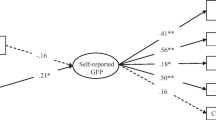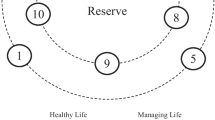Abstract
Life history theory is a fruitful source of testable hypotheses about human individual differences. However, this field of study is beset by unresolved debates about basic concepts and methods. One of these controversies concerns the usefulness of instruments that purport to tap a unidimensional life history (LH) factor based on a set of self-reported personality, social, and attitudinal variables. Here, we take a novel approach to analyzing the psychometrics of two variants of the Arizona Life History Battery: the Mini-K and the K-SF-42. Psychological network analysis generates models in which psychological variables (thoughts, feelings, or behaviors) comprise the nodes of a network, while partial correlation coefficients between these variables comprise the edges of the network. Centrality indices (strength, closeness, and betweenness) operationalize each node’s importance based on the pattern of the connections in which that node plays a role. Because childhood environments are hypothesized to influence adult LH, we tested the hypothesis that among the Mini-K items, and the K-SF-42 scales, those that tap relationships with parents are central to the networks (pairwise Markov random fields) constructed from these instruments. In an MTurk sample and an undergraduate sample that completed the Mini-K, and an MTurk sample that completed the K-SF-42, this hypothesis was falsified. Indeed, the “relationships with parents” items were among the most peripheral in all three networks. We propose that network analysis, as an alternative to latent variable modeling, offers considerable potential to test hypotheses about the input-output mappings of specific evolved psychological mechanisms.






Similar content being viewed by others
References
Baldini, R. (2015). Harsh environments and “fast” life history strategies: What does the theory say? BioRxiv. https://doi.org/10.1101/014647.
Barbaro, N., Boutwell, B. B., Barnes, J. C., & Shackleford, T. K. (2017). Genetic confounding of the relationship between father absence and age at menarche. Evolution and Human Behavior, 38, 357–365.
Belsky, J., Steinberg, L., & Draper, P. (1991). Childhood experience, interpersonal development, and reproductive strategy: An evolutionary theory of socialization. Child Development, 62, 647–670.
Black, C. J., Figueredo, A. J., & Jacobs, W. J. (2017). Substance, history, and politics: An examination of the conceptual underpinnings of alternative approaches to the life history narrative. Evolutionary Psychology, 15. https://doi.org/10.1177/1474704916670402.
Borsboom, D., & Cramer, A. O. (2013). Network analysis: An integrative approach to the structure of psychopathology. Annual Review of Clinical Psychology, 9, 91–121.
Boschloo, L., Van Borkulo, C. D., Rhemtulla, M., Keyes, K. M., Borsboom, D., & Schoevers, R. A. (2015). The network structure of symptoms of the diagnostic and statistical manual of mental disorders. PLoS One, 10, e0137621.
Boutyline, A., & Vaisey, S. (2017). Belief network analysis: A relational approach to understanding the structure of attitudes. American Journal of Sociology, 122, 1371–1447.
Brown, G. J., Laland, K. N., & Borgerhoff-Mulder, M. (2009). Bateman’s principles and human sex roles. Trends in Ecology and Evolution, 24, 297–304.
Copping, L. T., Campbell, A., & Muncer, S. (2014). Psychometrics and life history strategy: The structure and validity of the high K strategy scale. Evolutionary Psychology, 12, 200–222.
Copping, L. T., Campbell, A., Muncer, S., & Richardson, G. B. (2017). The psychometric evaluation of human life histories: A reply to Figueredo, Cabeza de Baca, Black, Garcia, Fernandes, Wolf, and Woodley (2015). Evolutionary Psychology, 15. https://doi.org/10.1177/1474704916663727.
Costantini, G., Epskamp, S., Borsboom, D., Perugini, M., Mõttus, R., Waldorp, L. J., & Cramer, A. O. (2015). State of the aRt personality research: A tutorial on network analysis of personality data in R. Journal of Research in Personality, 54, 13–29.
Cramer, A. O., Van der Sluis, S., Noordhof, A., Wichers, M., Geschwind, N., Aggen, S. H., et al. (2012). Dimensions of personality as networks in search of equilibrium: You can’t like parties if you don’t like people. European Journal of Personality, 26, 414–431.
Cramer, A. O., Waldorp, L. J., van der Maas, H., & Borsboom, D. (2010). Comorbidity: A network perspective. Behavioral and Brain Sciences, 33, 137–150.
Del Giudice, M. (2014). An evolutionary life history framework for psychopathology. Psychological Inquiry, 25, 261–300.
Del Giudice, M. (2018). Evolutionary psychopathology: A unified approach. New York: Oxford University Press.
Del Giudice, M., & Belsky, J. (2011). The development of life history strategies: Towards a multi-stage theory. In D. M. Buss & P. H. Hawley (Eds.), The evolution of personality and individual differences (pp. 154–176). New York: Oxford University Press.
Del Giudice, M., Gangestad, S. W., & Kaplan, H. S. (2015). Life history theory and evolutionary psychology. In D. M. Buss (Ed.), The handbook of evolutionary psychology (Vol. 1, 2nd ed., pp. 88–114). Hoboken: Wiley.
Del Giudice, M., Klimczuk, A. C. E., Traficonte, D. M., & Maestripieri, D. (2014). Autistic-like and schizotypal traits in a life history perspective: Diametrical associations with impulsivity, sensation seeking, and sociosexual behavior. Evolution and Human Behavior, 35, 415–424.
Ellis, B. J., & Bjorklund, D. F. (2012). Beyond mental health: An evolutionary analysis of development under risky and supportive environmental conditions: An introduction to the special section. Developmental Psychology, 48, 591–597.
Ellis, B. J., Figueredo, A. J., Brumbach, B. H., & Schlomer, G. L. (2009). Fundamental dimensions of environmental risk: The impact of harsh versus unpredictable environments on the evolution and development of life history strategies. Human Nature, 20, 204–268.
Epskamp, S., & Fried, E. I. (2018). A tutorial on regularized partial correlation networks. Psychological Methods, 23(4), 617–634. https://doi.org/10.1037/met0000167.
Epskamp, S., Borsboom, D., & Fried, E. I. (2018). Estimating psychological networks and their accuracy: A tutorial paper. Behavior Research Methods, 50, 195–212.
Epskamp, S., Cramer, A. O., Waldorp, L. J., Schmittmann, V. D., & Borsboom, D. (2012). qgraph: Network visualizations of relationships in psychometric data. Journal of Statistical Software, 48, 1–18.
Figueredo, A. J. (2007). The Arizona Life History Battery. http://www.u.arizona.edu/~ajf/alhb.html
Figueredo, A. J., Cabeza de Baca, T., Black, C. J., García, R. A., Ferreira, F. H. B., Wolf, P. S. A., & Woodley, M. A. (2015). Methodologically sound: Evaluating the psychometric approach to the assessment of human life history [Reply to Copping, Campbell, and Muncer, 2014]. Evolutionary Psychology, 13, 299–338.
Figueredo, A. J., Garcia, R. A., Menke, J. M., Jacobs, W. J., Gladden, P. R., Bianchi, J., Patch, E. A., Beck, C. J. A., Kavanagh, P. S., Sotomayor-Peterson, M., Jiang, Y., & Li, N. P. (2017). The K-SF-42: A new short form of the Arizona Life History Battery. Evolutionary Psychology, 15. https://doi.org/10.1177/1474704916676276.
Figueredo, A. J., Vásquez, G., Brumbach, B. H., & Schneider, S. M. R. (2007). The K-factor, covitality, and personality: A psychometric test of life history theory. Human Nature, 18, 47–73.
Figueredo, A. J., Vásquez, G., Brumbach, B. H., Schneider, S. M. R., Sefcek, J. A., Tal, I. R., et al. (2006). Consilience and life history theory: From genes to brain to reproductive strategy. Developmental Review, 26, 243–275.
Figueredo, A. J., Vásquez, G., Brumbach, B. H., Sefcek, J. A., Kirsner, B. R., & Jacobs, W. J. (2005). The K-factor: Individual differences in life history strategy. Personality and Individual Differences, 39, 1349–1360.
Figueredo, A. J., Wolf, P. S. A., Olderbak, S., Gladden, P. R., Fernandes, H. B. F., Wenner, C., et al. (2014). The psychometric assessment of human life history strategy: A meta-analytic construct validation. Evolutionary Behavioral Sciences, 8, 148–185.
Fruchterman, T. M. J., & Reingold, E. M. (1991). Graph drawing by force-directed placement. Software: Practice and Experience, 21, 1129–1164.
Geary, D. C. (2002). Sexual selection and human life history. Advances in Child Development and Behavior, 30, 41–104.
Gruijters, S. L. K., & Fleuren, B. P. I. (2018). Measuring the unmeasurable: The psychometrics of life history strategy. Human Nature, 29, 33–44.
Isvoranu, A. M., Borsboom, D., van Os, J., & Guloksuz, S. (2016). A network approach to environmental impact in psychotic disorders: Brief theoretical framework. Schizophrenia Bulletin, 42, 870–873.
Jeschke, J. M., Gabriel, W., & Kokko, H. (2008). R-strategists/K-strategists. In S. E. Jørgensen & B. D. Fath (Eds.), Encyclopedia of ecology (pp. 3113–3122). Oxford: Elsevier.
Lakoff, G. (2002). Moral politics: How liberals and conservatives think. Chicago: University of Chicago Press.
Lukaszewski, A. W. (2019). Evolutionary perspectives on the mechanistic underpinnings of personality. The Handbook of Personality Dynamics and Processes (in press). Elsevier. (Preprint: https://psyarxiv.com/b4hc3/).
Manson, J. H. (2015). Life history strategy and the HEXACO personality dimensions. Evolutionary Psychology, 13, 147470491501300104.
Manson, J. H. (2017). Are extraversion and openness indicators of a slow life history strategy? Evolution and Human Behavior, 38, 552–560.
Musek, J. (2007). The general factor of personality: Evidence for the big one in the five-factor model. Journal of Research in Personality, 41, 1213–1233.
Olderbak, S., Gladden, P. R., Wolf, P. S. A., & Figueredo, A. J. (2014). Comparison of life history strategy measures. Personality and Individual Differences, 58, 82–88.
R Core Team. (2019). R: A language and environment for statistical computing (version 3.3.0). Vienna: R Foundation for Statistical Computing. Retrieved from https://www.r-project.org/.
Richardson, G. B., Chen, C.-C., Dai, C.-L., Brubaker, M. D., & Nedelec, J. L. (2017a). The psychometrics of the mini-K: Evidence from two college samples. Evolutionary Psychology, 15, 1474704916682034.
Richardson, G. B., Sanning, B. K., Lai, M. H. C., Copping, L. T., Hardesty, P. H., & Kruger, D. J. (2017b). On the psychometric study of human life history strategies: State of the science and evidence of two independent dimensions. Evolutionary Psychology, 15. https://doi.org/10.1177/1474704916666840.
Rushton, J. P. (1985). Differential K theory: The sociobiology of individual and group differences. Personality & Individual Differences, 6(4), 441–452.
South, S. J., Haynie, D. L., & Bose, S. (2005). Residential mobility and the onset of adolescent sexual activity. Journal of Marriage and the Family, 67, 499–514.
Stearns, S. C. (1992). The evolution of life histories. Oxford: Oxford University Press.
Stearns, S. C., & Rodrigues, A. M. M. (2020). On the uses of “life history theory” in evolutionary psychology. Evolution and Human Behavior. https://doi.org/10.1016/j.evolhumbehav.2020.02.001.
Tibshirani, R. (1996). Regression shrinkage and selection via the lasso. Journal of the Royal Statistical Society B, 58, 267–288.
Trivers, R. L. (1972). Parental investment and sexual selection. In B. Campbell (Ed.), Sexual selection and the descent of man (pp. 136–179). Chicago: Aldine.
Wilson, M., & Daly, M. (1997). Life expectancy, economic inequality, homicide, and reproductive timing in Chicago neighborhoods. British Medical Journal, 314, 1271–1274.
Zietsch, B. P., & Sidari, M. J. (2019). A critique of life history approaches to human trait covariation. Evolution and Human Behavior. https://doi.org/10.1016/j.evolhumbehav.2019.05.007.
Acknowledgments
We thank Jacob Foster for discussions. Portions of this research were funded by the Academic Senate of the University of California, Los Angeles.
Author information
Authors and Affiliations
Corresponding author
Additional information
Publisher’s Note
Springer Nature remains neutral with regard to jurisdictional claims in published maps and institutional affiliations.
Electronic supplementary material
ESM 1
(PDF 1.72 mb)
Rights and permissions
About this article
Cite this article
Manson, J.H., Chua, K.J. & Lukaszewski, A.W. The Structure of the Mini-K and K-SF-42. Hum Nat 31, 322–340 (2020). https://doi.org/10.1007/s12110-020-09373-6
Published:
Issue Date:
DOI: https://doi.org/10.1007/s12110-020-09373-6




